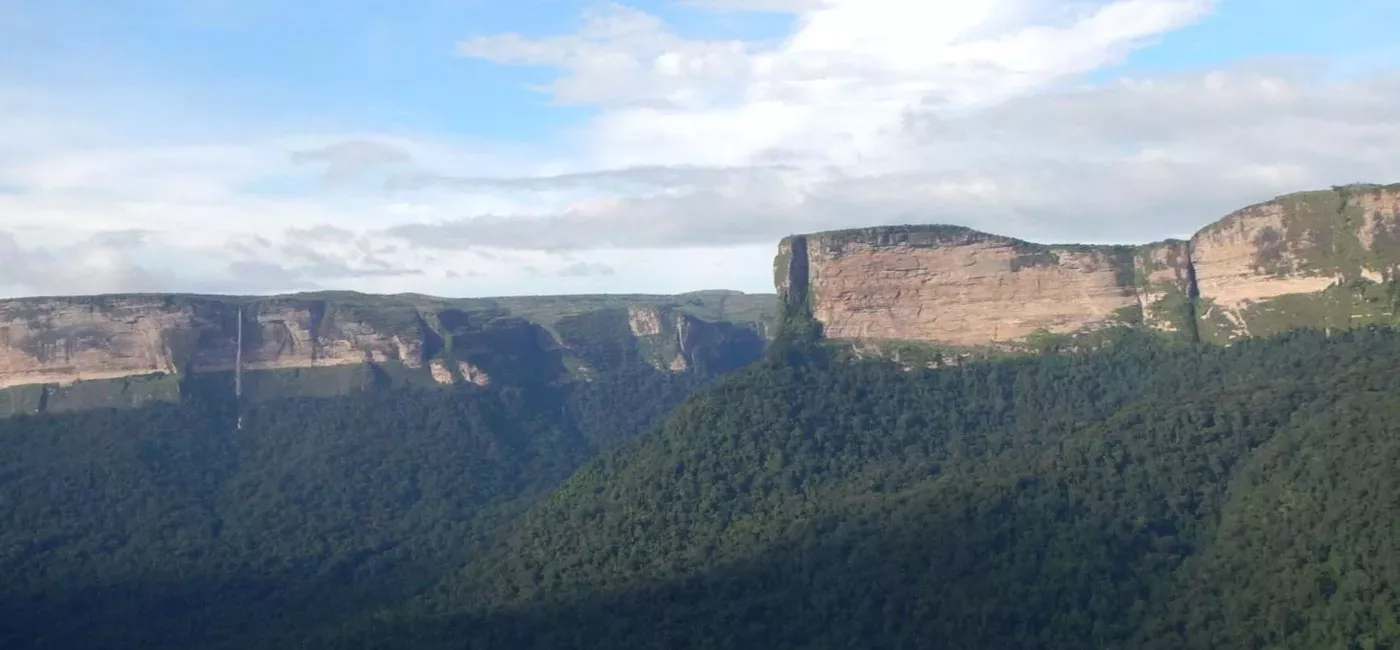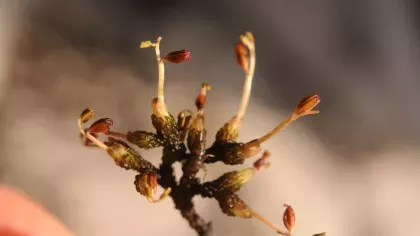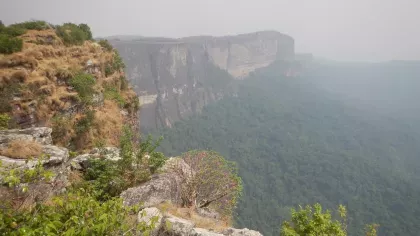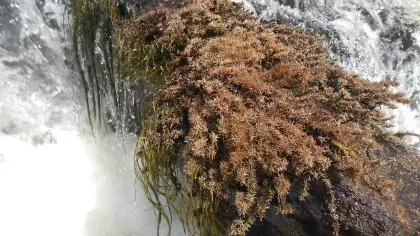9 December 2021
Taking the plunge: waterfall plants under threat
The construction of hydroelectric dams at waterfalls, as well as tourism, look to be posing major threats to waterfall plants in tropical areas.

Today marks the publication of the latest update of the International Union for Conservation of Nature Red List for Threatened Species™ (IUCN Red List) to include 142,577 species in total and 58,343 plant species.
In this update, the plight of freshwater and wetland systems has been specifically highlighted by IUCN.
While the conservation status of freshwater animals is well documented to be precarious, freshwater plants are often widespread and comparatively resilient to extinction risk.
In fact, about 75% of freshwater plants published on the Red List have been assessed as Least Concern, compared to just 50% for other freshwater taxa.
A notable exception to this generalisation are plants growing in and around waterfalls in tropical areas.
Members of the “orchids of the falls” or Podostemaceae family, in particular, are often restricted to just a single set of falls or rapids.
These narrow distributions inherently increase the risk of extinction for these species, which is only exacerbated by human activity.
For freshwater and wetland systems on the whole, unsustainable agriculture and urbanisation are the key drivers of species decline; for waterfall plants growing in tropical areas, it is the construction of dams for hydroelectric power that often poses the most significant threat and has already resulted in global extinction of several species in Africa.
Dammed if we do, damned if we don’t
While hydroelectric power appears preferable to non-renewable alternatives, the construction of dams at waterfalls can have devastating impacts on wildlife.
As well as directly impacting the species on the waterfalls at the site of construction, dams can also impact waterfall plants via subsequent changes in water flow.
One such hydroelectric project is the dam on the Memve’ele falls of Ntem River in Cameroon, expected to be fully operational in 2022.
Multiple highly restricted aquatic or semi-aquatic plants growing in fast-flowing water or white water (known as rheophytes) have only been recorded at and downstream of the Memve’ele falls, including Psychotria torrenticola, added to the IUCN Red List for the first time in today’s update.
They are adapted to this extreme environment through lanceolate (narrow and oval) leaves, slender and flexible but tough stems, and strong usually fibrous, root systems.
Alteration in seasonal water levels can be highly detrimental to their survival, as they tend to flower or fruit in response to lower water levels.
Given its restricted distribution, and the severe threat posed by the imminent completion of the Memve’ele hydroelectric project, Psychotria torrenticola has been assessed as Critically Endangered, the highest category of extinction risk.
This species is the fifth rheophyte occurring at or downstream of the Memve’ele project that has been assessed as Critically Endangered, with more likely to be added to the IUCN Red List in 2022.
Without intervention, it is very possible that several of these species will soon be Extinct.

The dam at Memve’ele is far from an isolated example: Inversodicraea koukoutamba, known only from the Koukoutamba falls on the Bafing River in Guinea, is also included on the IUCN Red List for the first time and is assessed as Critically Endangered.
The same reason, different hydroelectric project.
In this case, it’s the planned Koukoutamba Hydroelectic Power Station threatening the species’ survival.
It is essential, therefore, that hydroelectric dam projects are undertaken with due consideration for the fragile ecosystems their construction will impact.

Don’t go chasing waterfalls
When we think of waterfalls, though, we don’t think of dams.
First and foremost, we probably think of waterfalls as something to admire.
In fact, the Victoria Falls are one of the seven natural wonders of the world.
While trampling by tourists may seem like a minor threat compared to that posed by hydroelectric projects, any threat is significant to a species if it is restricted to a single waterfall.
The Lobé falls in Cameroon are the most species diverse site documented for Podostemaceae in Africa.
These spectacular falls cascade into the sea next to a beach resort, and are frequented by large numbers of tourists.
Inversodicraea eladii, included for the first time on the IUCN Red List, is only known from the Lobé falls.
Owing to its highly restricted distribution, and the potential impact of tourist activity, it has also been assessed as Critically Endangered.
Conversely, well-managed ecotourism may also be the best hope for in situ protection of the unassuming plants clinging to the Lobé Falls.
As long as the spectacular landmark continues to inspire awe in visitors, the site is more likely to be spared from exploitation for larger commercial or industrial developments.

Stemming the flow
Fortunately, all of the falls mentioned lie within sites recently designated as Tropical Important Plant Areas (TIPAs) in Cameroon and Guinea.
The TIPAs project helps to prioritise conservation by focussing on sites of particular importance for threatened, endemic and other valuable species.
Sites proposed in Cameroon so far, including Memve’ele and Lobé, accommodate around 70% of threatened species across approximately 4% of the area of Cameroon.
As well as documenting species presence at TIPA sites, Kew scientists are working with local partners to protect species through further monitoring, dissemination of knowledge, promotion of sustainable livelihoods, restoration of habitat, and propagation in local nurseries.


In areas targeted for hydroelectric projects in Cameroon, such as Memve’ele, we are investigating the possibility of transplanting some species from affected sites, though this is not expected to be easy or straightforward.
This activity would complement existing ex situ conservation involving collection of seed for storage in the seedbank of the Cameroon National Herbarium and Kew's Millennium Seed Bank.
Through the publication of these species on the IUCN Red List, and the implementation of in situ and ex situ conservation measures, we hope to protect this unique flora of rheophytes, and to raise the profile of these fascinating plants to those attracted to the less conspicuous of nature’s wonders.
IUCN Red List Assessments
Lovell, R. & Cheek, M. (2021) Inversodicraea eladii. The IUCN Red List of Threatened Species 2021.
Cheek, M. (2021) Inversodicraea koukoutamba. The IUCN Red List of Threatened Species 2021.
Lovell, R. & Cheek, M. (2021) Psychotria torrenticola. The IUCN Red List of Threatened Species 2021.
Acknowledgements
We would like to thank Eric Ngansop, Olivier Sene and Barthelemy Tchiengue of the National Herbarium of Cameroon, and Xander van der Burgt of Kew for their fieldwork and data relating to the Memve’ele falls.
We would also like to acknowledge our former colleagues of the Kew Plant Assessment Unit for their crucial expertise and energy in conducting the extinction risk assessments for the species referenced in this blog.
Finally, with thanks to Players of People’s Postcode Lottery, and the Jack S Cohen Foundation for their generous funding of ongoing work on Tropical Important Plant Areas in Cameroon.
References
Cheek, M., Molmou, D., Magassouba, S.& Ghogue, J.-P. (2021). Taxonomic Monograph of Saxicolella (Podostemaceae), African waterfall plants highly threatened by Hydro-Electric projects, with five new species. bioRxiv
Cheek, M., Séné, O. & Ngansop, E. (2020) Three new Critically Endangered Inversodicraea (Podostemaceae) species from Tropical Africa: I. senei, I. tanzaniensis and I. botswana. Kew Bulletin, 75: 31.
Cheek, M., Molmou, D., Jennings, L. et al. (2019) Inversodicraea koukoutamba and I. tassing (Podostemaceae), new waterfall species from Guinea, West Africa. Blumea, 64: 216-224.
Kuetegue, F., Sonké, B. & Ameka, G.K. (2019) A checklist of rheophytes of Cameroon. PhytoKeys 121: 81–131.
Cheek, M., Feika, A., Lebbie, A., et al. (2017) A synoptic revision of Inversodicraea (Podostemaceae). Blumea, 62: 125-156.





